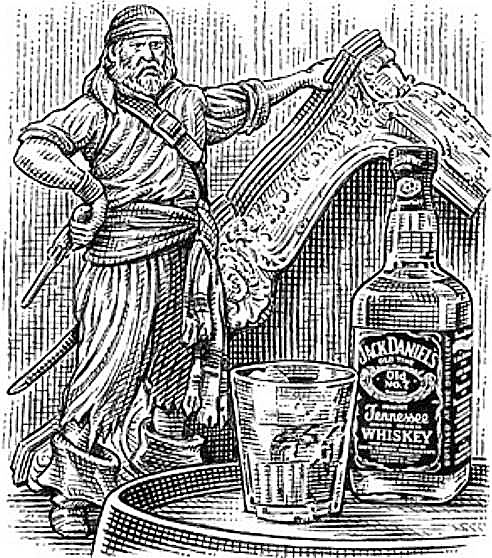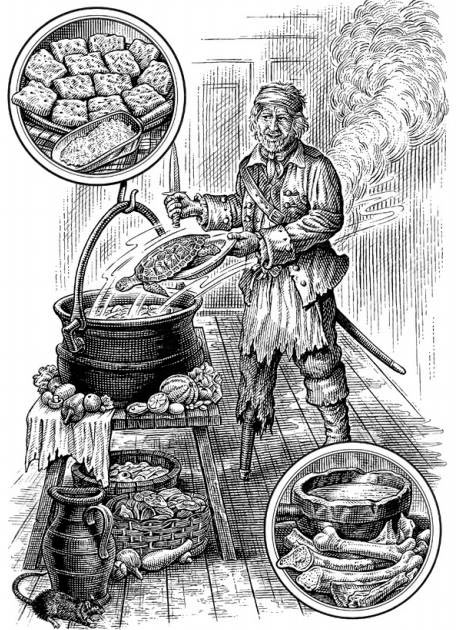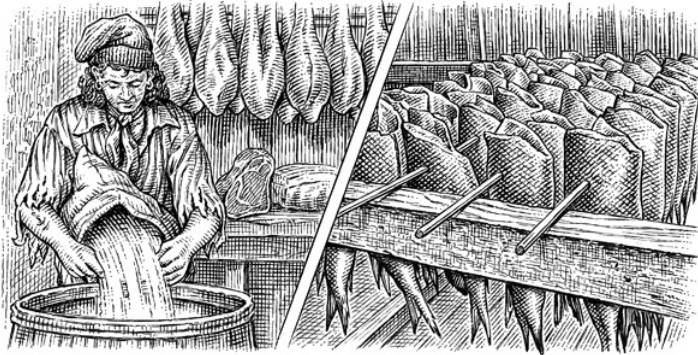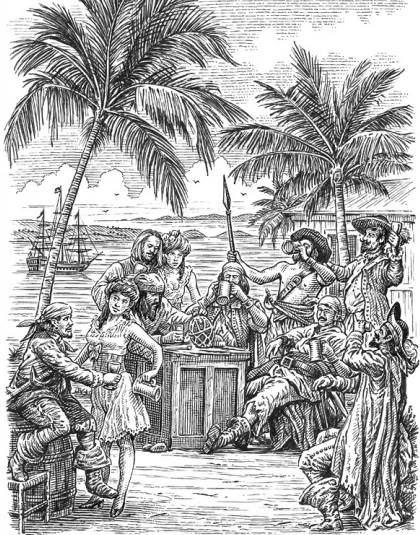Discover the intriguing world of pirates food and drink, from Blackbeard’s table to the infamous pirate haven of Tortuga. Learn about their love for rum, notorious drinking habits, and the simple, hearty meals like bone soup that kept them going on the high seas.
Explore the diet and drinking habits of pirates in this detailed article. Learn about the infamous Blackbeard, the drinking culture among pirates, and notorious tales like «A Drunken Pirate and His Head are Soon Parted!» Discover what made up their meals, including bone soup, and the significance of places like Tortuga in pirate lore.
Grub & Grog
«Such a day; rum all out. Our company somewhat sober; a damned confusion amongst us! Rogues a-plotting. Talk of separation. So I looked sharp for a prize [and] took one with a great deal of liquor aboard. So kept the company hot, damned hot, then all things went well again.»
Blackbeard
Pillaging and plundering requires energy lots of it so when it comes to food and drink, we pirates can’t afford to be picky. This means choking down some things that would make a billy goat vomit. But since necessity is the mother of invention, this caused us to create some interesting foodstuff combinations, many of which will transform gastronomic horror shows into a feast fit for a king a pirate king, that is!
Food preservation is a big problem on any ship, Typical Activities Aboard the Pirate Ship, the Pirate Codepirate ships included. Food items tend to spoil, rot, and mold over rather quickly, especially considering the humidity and salt air. The fresh meats, fruits, vegetables, and cheeses at the start of the voyage last about a week-if the crew is lucky. Cackle fruit can be had, provided the chickens have food. But once they stop laying eggs-or die-the birds go into the pot. Ditto for cows and fresh milk. Once the cow’s food supply is exhausted, fresh meat finds its way onto the menu.
The rest of the food items have to be specially prepared to last and not go rancid. This usually means pickling or salting. Before long, bread is crawling with weevils, so hardtack biscuits-which last for an entire year-are a popular alternative, although some liken them to «digestible leather». Still, when a stomach is empty and grumbling, they hit the spot.
A good cook is worth his weight in gold, for a well-fed pirate is a happy pirate, and that means no mutinies for the captain and his officers to worry about. Experienced cooks are well versed in the use of exotic spices commonly found throughout the Caribbean island nations and, by relying on traditional native cooking methods, are capable of turning food items long past their prime into dishes that are not only edible but delicious.
Of course, depending on the conditions, location of the vessel, and success at finding prey, there are times when the pickings are beyond slim, which is just one of the reasons you don’t see many so-called pets aboard a pirate ship. Colorful and often talkative shoulder-perched parrots won’t last very long on a vessel full of starving pirates; undoubtedly, the captain would be the first to devour his companion bird.
Boucan
Meat prepared in a barbecue-like manner. It’s where the term buccaneer derives from.
Cackle Fruit
Chicken Eggs.
Kill-Devil
A potent combination of rum with a little gunpowder sprinkled on it.
Scurvy
A nasty disease resulting from a vitamin C deficiency, scurvy leads to the formation of spots on the skin, bleeding gums, and loss of teeth, and can be fatal if not treated. To avoid contracting scurvy, drink juice or eat fruit high in vitamin C:
- oranges;
- grapefruits;
- lemons;
- limes;
- kiwis;
- and strawberries.
Bacchanal
A riotous, drunken party. Some pirate bacchanals last for weeks.
A Drunken Pirate and His Head are Soon Parted!
In their hunt for the notorious Blackbeard, LIEUTENANT ROBERT MAYNARD commanded the JANE with a 35-man crew, followed by midshipman Mr. Hyde on the Ranger with a crew of 25. Slowly and cautiously, the two sloops navigated their way through Ocracoke’s winding channel, all the while being observed by Blackbeard aboard his ADVENTURE. By nightfall on November 21, 1718, the two sloops had anchored and were preparing for an early morning attack. Unafraid, Blackbeard and his 18-man crew drank heavily throughout the night. The following day, Blackbeard lost the battle and, ultimately, his head.
Apparently, Blackbeard’s demise by hangover was paid no heed by BARTHOLOMEW «BLACK BART» ROBERTS. On February 10, 1722, the British warship HMS Swallow, under Captain Challoner Ogle, caught up with Black Bart’s 42-gun Royal Fortune off the coast of Cape Lopez. Roberts’s crew was still feeling the effects of the previous night’s celebration and were ill-prepared for battle. Roberts ordered his crew to man their stations and steered directly at the Swallow in an effort to blast his way into open seas. The ships exchanged a devastating broadside, and when the smoke cleared, Roberts was found slumped over one of his big guns, a blast of grapeshot to the throat.
Pirates Love Their Drink!
When pirates attacked a ship in the Gulf of Mexico headed to New Orleans, among the plundered booty was a hand-carved Italian marble fireplace mantel. Just as they were about to heave the mantel into the sea, one of the pirates read the attached shipping information and immediately stopped the action. The mantel was en route to Lynchburg, Tennessee, to the home of MR. JACK DANIEL. Because pirates have such an affinity for Jack Daniel’s signature creation, Old No. 7 whiskey, they immediately repacked the mantel and shipped it to its rightful owner.

What’s for Dinner?
- BARRELS OF FRESHWATER, as many as the ship can hold. Depending on sailing location, replenishing sources may not be readily available.
- FRESH FRUIT prevents scurvy.
- FRESH VEGETABLES are eaten first, before they spoil.
- FRESH meat and seafood seldom last more than a week unless cured/salted.
- CHICKENS for eggs; eaten when chicken feed runs out or if they die.
- COWS for milk; eaten when their food is gone or if they die.
- HARDTACK BISCUITS can last up to a year if kept dry, whereas bread lasts less than a week before becoming infested with weevils.
- OIL, VINEGAR, AND VARIOUS SPICES. Hot spices (chili peppers) are preferred because they mask the taste of spoiled/rancid food.
- WINE, RUM, OR ANY OTHER SPIRIT. Pirates will gladly drink anything with alcohol in it.
Grog
The word grog comes to us from «Old Grogram», the nickname given to British Rear Admiral Edward Vernon, who ordered his sailors’ rum rations to be diluted, both to make them last and to prevent drunkenness. The diluting took place in a large barrel, commonly referred to as a grog tub.
- 1 ounce rum per every.
- 7 to 9 ounces of water.
- 1 or 2 teaspoons cane sugar Lime juice.
MIX WITHOUT ICE and serve straight up.
Bumbo/Bumboo/Bumbo
A simple drink consisting of:
- rum;
- water;
- sugar;
- and nutmeg,
bumboo is far better tasting than grog.
- 2 ounces dark rum.
- 1 ounce chilled water.
- 2 brown/cane sugar cubes or 2 teaspoons sugar syrup Sprinkle of cinnamon Sprinkle of nutmeg
COMBINE ALL INGREDIENTS, stir, and serve without ice.
Rumfustian
- 2 egg yolks.
- 1 teaspoon sugar.
- 2 ounces gin.
- 2 ounces sherry.
- 1 cup ale.
- Pinch ground cinnamon.
- Peel of 1 lemon.
- 2 to 3 cloves.
- Pinch ground nutmeg.
IN A BOWL, beat egg yolks with sugar. In a saucepan, combine:
- gin;
- sherry;
- ale;
- cinnamon;
- lemon peel;
- and cloves and bring to the boiling point.
Pour in egg/sugar mixture, stirring briskly. If any snot or blood happens to fall into the mixture, leave it. It’ll definitely improve the taste! Serve in a mug and top with nutmeg.
Hardtack Biscuits
Hardtack biscuits are square crackers carried on ships as sustenance for long sea voyages because they are easy to make and last forever-even though with age they become hard as rocks!
Preheat Oven to 400 °F.
- 1 1/2 to 2 cups water.
- 4 cups flour.
- 3 to 4 teaspoons salt.
- 2 tablespoons shortening (if available).
MIX INGREDIENTS in a bowl by hand, adding just enough water to make the mixture stick together. Dough should not stick to your hands. Roll dough and shape into a crude rectangle. Bake at 400 F for 1 hour. Remove from oven and cut dough into 3-by-3- inch squares. Using a fork or knife-tip, punch four rows of holes (four per row) into each square. Flip biscuits over and return to oven for 30 minutes. Cool.
Salmagundi
Occasionally called «salmi», salmagundi-salmagundis is French for «hodgepodge»-is a cold salad-type dish featuring cooked:
- meats;
- seafood;
- vegetables;
- fruit;
- leaves;
- nuts,
and/or flowers, dressed with a mixture of oil, vinegar, and available spices. Some pirates prefer their salmagundi hot, more like a stew. The kind and amount of ingredients is up to you, but here is an example of how you might make this common dish:
- CUT COLD ROAST CHICKEN;
- DUCK, AND ANY OTHER AVAILABLE MEAT,
into slices and place in a large pot. Add chopped onion and tarragon. Add:
- olives;
- capers;
- raisins;
- mushrooms;
- almonds (and any other available nuts);
- peas;
- and red and white currants.
Add lime, lemon, and orange slices/wedges. Cover with oil, vinegar, and lemon juice. Mix thoroughly. Serve cold, garnished with slices of orange and lemon.
Bone Soup
Food shortages aboard pirate ships are common. When a lack of sustenance befalls the ship, desperate times require desperate measures. As long as we have fresh water to boil and there are fish/animal skeletons on board the very reason we pirates save our bones bone soup is in order. Granted, there ain’t much to it, just a mealy broth with little (if any) taste and some beneficial nutrients but, compared to an empty bowl, plate, or mug, bone soup is akin to a lavish spread.

Curing/Salting Meat
Also known as salt-curing meat in brine.
- Fill brine barrel halfway with hot water.
- Add salt, using a ratio of 1 cup salt per 2 gallons water.
- Add ½-1 cup vinegar and brown sugar (optional) to the mixture.
- Cut meat into chunks and submerge in mixture.
- Allow meat to soak for 6 to 7 days.
- Remove meat from barrel, dry off, and place in sacks or in flour to keep flies and other insects away.
- Hang in a cool, dry place (if available) to dry.
Curing/Salting Fish
- Remove head, scales, and guts. Toss in ocean as chum to attract sharks for more fun and games.
- Bleed carcass thoroughly.
- Rub with salt, completely covering fish and leaving no open spaces.
- Pack fish into a large jar or barrel, skin side up, alternating a layer of fish with a layer of salt.
- Seal jar/barrel and leave for 12 to 15 days.
- Remove fish from barrel, rinse off salt, then place on flat surface and press fish as flat as possible to remove excess moisture.
- If properly salted, fish flesh should be nearly translucent and no undo «rank» odor should exist.
- Final drying should take place in a dry, well-ventilated area. Fish can be laid flat or, ideally, hung.
- Final drying can take place in sunlight, although reserve this for the second day of the process, as immediate exposure to sunlight after removal from curing barrel may harden flesh or turn it yellow.

Of the said potatoes also they make a drink called Maiz. They cut them into small slices, and cover them with hot water. When they are well imbibed with water, they press them through a coarse cloth, and the liquor that comes out, although somewhat thick, they keep in vessel made for that purpose. Here, after settling two or three days, it begins to work; and, having thrown of its lees, is fit for drink. They use it with great delight, and although the taste is somewhat sour, yet it is very pleasant, substantial, and wholesome. The industry of this composition is owing to the Indians, as well as many others, which the ingenuity of those barbarians caused them to invent both for the preservation and the pleasure of their own life. Alexandre Exquemelin, Bucaniers of America (1684).
Tortuga
This island off the coast of Haiti has long been a hideout for pirates; those who routinely hole up here like to refer to themselves as the Brethren of the Coast. It’s a good place to stop for provisioning the governor once imported more than 1 600 prostitutes to «calm things down» – so you might as well stay awhile and enjoy yourself.

